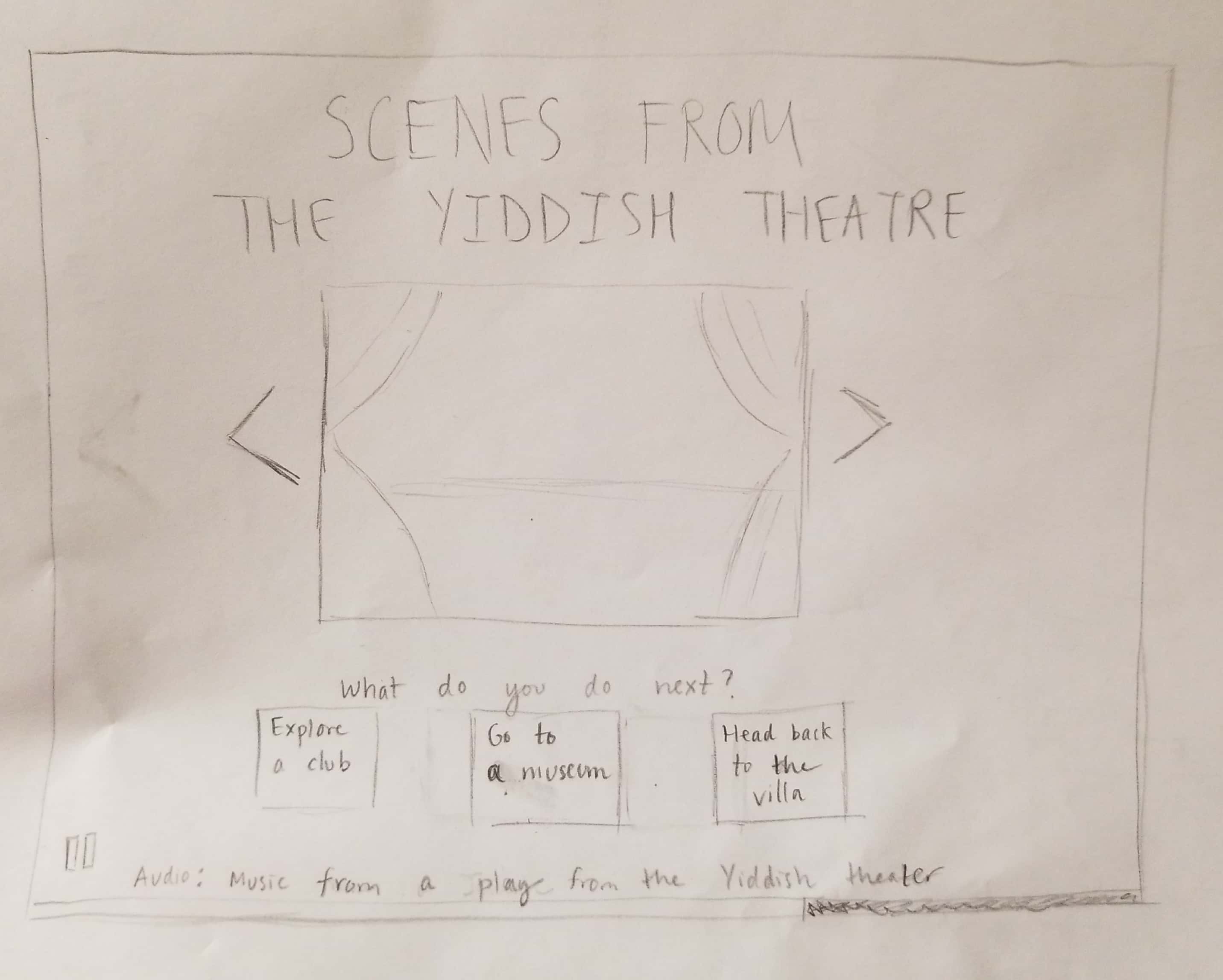Project Ideas & Updates
-
Final Project Design Paper and Presentation
Design Paper
Presentation Slides
-
Assignment 5 - Jasmine Yuan
Final Project Connections
Updates
I looked into the book “Passing Illusions: Jewish Visibility in Weimar Germany” by Kerry Wallach, which provides some insight into the presentation of Jewishness during the time period in Germany. Wallach examines constructs of German-Jewish identity, and the reasons for concealing and revealing this identity through performance, cultural products, and other public displays. The Weimar Republic represents an opening up of possibilities as well as a closing in fueled by nationalism and the end of the war. With the renewed sense of identity in the Jewish community in the Weimar era came an increase in hostility and anti-Semitic sentiments.
I also explored the book “Three-Way Street: Jews, Germans, and the Transnational”, which examines the transnational identity of German-Jews. Rosenfeld’s essay “Between Memory and Normalcy: Synagogue Architecture in Postwar Germany” discusses the significance of the construction history of synagogues and how these buildings of worship reflect the community’s identity. The architecture is shaped by these postwar cultural and societal trends. Weiss’s essay “Klezmer in the New Germany: History, Identity, and Memory” explores the connections of traditional Klezmer music to Jewish settlements and the differences in identities and associations with native German-Jews. The music is significant due to its politically charged nature, cultural ties, and public reception in Germany.
The Jewish Life in Berlin project should explore these societal issues, and how they are represented through public performance and entertainment culture. These will be viewed and revealed through the lens of the figures that will be represented on the website.
Connections
The network of the archive should contain nodes of figures and places that are connected by interactions.
-
The Comedian Harmonists are connected to many areas of the music network in 1920s Berlin. Harry Frommermann, a Jewish member and founder of the Comedian Harmonists can act as a node in the network. The Comedian Harmonists performed at the Kabarett der Komiker in October 1928, making a crossover to the cabaret scene. The Comedian Harmonists are also the first popular-music group to play in the Berlin Philharmonic hall, connecting to the concert music scene by performing popular music in a formal concert venue.
-
Friedrich Hollaender composed “Just Suppose” and “Lavender Song”, which were performed in the cabaret. These songs are highly topical, referencing homosexuality and the “liberal culture” of politics in the cabaret. Several figures who have performed Hollaender’s songs in the cabaret include Valeska Gert, a cabaret actress, and Curt Bois, a cabaret performer. Hollaender not only composed music for the cabaret but also for theater productions and films. Hollaender later had to leave Nazi Germany in 1933 due to his Jewish descent.
-
Hollaender is connected to Berlin’s Metropol-Theater, which developed into an operetta stage in the 1920s. Hollaender’s father, Victor Hollaender, composed operettas and revues for the theater. The Metropol-Theater revues were important in shaping popular entertainment culture with their depiction of political satire and parody. Its messages were directly influential to other forms of popular media and music genres. The cabaret, popular songs, and operettas echoed messages of the Metropol Theater revues. (https://jewishlifeinberlin.slack.com/messages/CGG5SU7UJ/files/FGJLWP9RR/)
-
Friedrich Hollaender, Hanns Eisler, Kurt Weill, and Bertolt Brecht collaborated on revues and were involved in creating works for the theater. Kurt Weill composed operas, film music, and symphonic music for orchestra and choir. He developed productions for the theater such as The Threepenny Opera with Brecht, which contained political themes. Weill also faced financial hardships. Weill joined the Novembergruppe in 1922, which contained radical Berlin artists including Hanns Eisler.
First page of Weill’s manuscript:
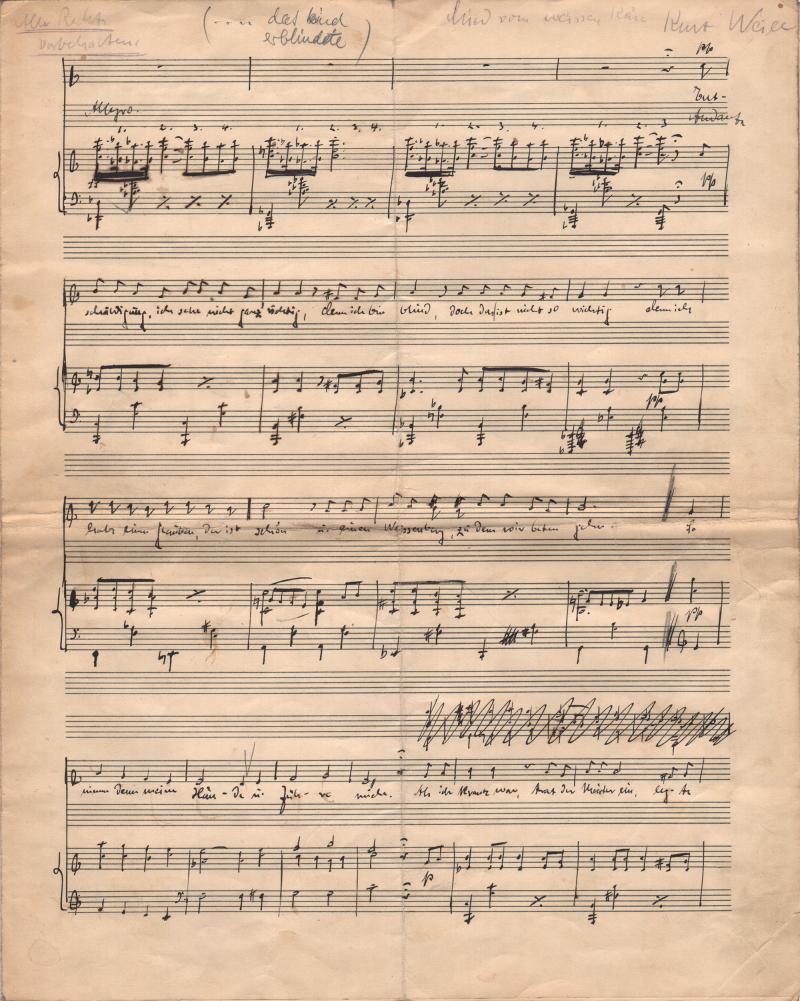
- Hanns Eisler studied under Arnold Schoenberg from 1919 to 1923, and he composed classical works for concert performance using Schoenberg’s twelve-tone technique. Later on, his music began incorporating political themes as well as drawing popular music influences from jazz and the cabaret. Eisler’s music acts as a transition from and a connection between formal classical concert music into the popular music of Weimar’s jazz age. Additionally, Eisler wrote music for several Brecht plays. (https://www.broadwayworld.com/article/Previously-Unknown-Kurt-Weill-Song-Discovered-in-Berlin-Archive-20171106 https://www.nytimes.com/2000/02/27/arts/music-when-cabaret-had-an-edge.html)
Visual layout & audience experience ideas
- Having the nodes in the network be represented by tables in a cabaret
- Having a dynamic experience for the user, where each time they explore the archive, they traverse the network in a different path.
- First time users can enter the network by experiencing a song playing at the beginning. Frequent users can have an option to directly enter the network instead of learning through the randomly generated song.
Katrin sent me these links to sheet music today that I will delve into later:
- https://fau.digital.flvc.org/islandora/search/?type=edismax&collection=fau%3Apsm
- http://jmwc.org/publishers-scores-and-music/
- https://www.jwpepper.com/sheet-music/jewish-songbooks.list
- https://yivo.org/music
- https://library.brown.edu/dps/curio/category/collections/yiddish-sheet-music/
-
-
Assignment 4 - Jasmine Yuan
Final Project Conceptualization
Updated Journey Map
The website begins by playing a random music selection. The user learns more about a key figure involved in the music, such as the composer or performer. They enter the network of the music community in Berlin in the 1920s through this figure. From there, the user experiences a “day in the life” of this person, and chooses a journey to follow as they explore different aspects of the music scene while learning more about their historical lives. I want the site to showcase the importance of music in defining Jewish communal identity and history.
Making the archive more active:
One idea I had of making the archive more participatory is to allow users to collect the music from the website into their own playlist. From there, they can group the songs in the playlist according to metadata such as the composers, performers, genre, and places performed. They can find connections between the music this way.
Core topics:
The main idea is to have the user explore the life of figures involved in the music scene as they navigate through:
- Popular music culture: Popular music trends, the “jazz age” & musical influences, and the life of Jewish performers in 1920s Germany - through the lens of Harry Frommermann (Jewish member and founder of the Comedian Harmonists)
- Political satire, gender, and sexuality in the weimar cabaret - through the lenses of Curt Bois (performer), Valeska Gert (performer) and Friedrich Hollaender (composer). Focus on the Kabarett der Komiker, as the Comedian Harmonists performed there in October 1928
- Concert music - lenses of Berta Geissmar (orchestra manager & secretary) and Franz Schreker (composer). The Comedian Harmonists make a crossover by performing popular music in concert halls. They are the first popular-music group to play in the Berlin Philharmonic hall.
- Religious & synagogue music - music in sacred rituals, Jewish religious life, and the influence of synagogue music on popular song today. Focus on the New Synagogue.
People:
- Curt Bois (https://en.wikipedia.org/wiki/Curt_Bois) - cabaret
- Friedrich Hollaender (https://en.wikipedia.org/wiki/Friedrich_Hollaender) - cabaret composer
- Harry Frommermann (https://en.wikipedia.org/wiki/Comedian_Harmonists) - member of the Comedian Harmonists
- Valeska Gert (https://en.wikipedia.org/wiki/Valeska_Gert) - cabaret actress
- Berta Geissmar (https://en.wikipedia.org/wiki/Berta_Geissmar) - connections to Berlin Philharmonic
- Franz Schreker (https://en.wikipedia.org/wiki/Franz_Schreker) - composer, concert & opera
Articles:
- “Lavender Songs: Undermining Gender in Weimar Cabaret and Beyond”- Alan Lareau (https://jewishlifeinberlin.slack.com/messages/CGG5SU7UJ/files/FGK44MY93/)
- “The German Cabaret Movement during the Weimar Republic” - Alan Lareau (https://jewishlifeinberlin.slack.com/messages/CGFDY3L5N/files/FGK44MY93/)
- “Reading Uncle Bumba and the Rumba: The Comedian Harmonists and Transnational Youth Culture at the End of the Weimar Republic” - Stephan Pennington (https://jewishlifeinberlin.slack.com/messages/CGFDY3L5N/).
- “Visual Music: Jazz, Synaesthesia and the History of the Senses in the Weimar Republic” - Michael J. Schmidt (https://jewishlifeinberlin.slack.com/messages/CGG5SU7UJ/files/FGJ72MT4H/)
- “Popular Entertainment and Mass Media: The Central Arenas of German-Jewish Cultural Engagement” (https://jewishlifeinberlin.slack.com/messages/CGG5SU7UJ/files/FGJLWP9RR/) - socioeconomic class & popular culture
- “The Jazz Republic, Music, Race, and American Culture in Weimar Germany” - Jonathan O. Wipplinger (https://jewishlifeinberlin.slack.com/messages/CGG5SU7UJ/files/FGJ29PWL8/)
- “Jews and Music” - Judah Cohen (http://www.oxfordbibliographies.com/view/document/obo-9780199840731/obo-9780199840731-0063.xml)
- Synagogue Music https://www.myjewishlearning.com/article/synagogue-music/
Images:
- Kabarett der Komiker (Cabaret of Comedians) http://www.cabaret-berlin.com/?p=87 https://commons.wikimedia.org/wiki/Category:Kabarett_der_Komiker
- Scala https://commons.wikimedia.org/wiki/Category:Scala_(Berlin) http://www.cabaret-berlin.com/?p=41
- Synagogues https://en.wikipedia.org/wiki/New_Synagogue,_Berlin https://commons.wikimedia.org/wiki/File:Berlin_Synagoge_Oranienburgerstrasse_Grundriss.jpg https://commons.wikimedia.org/wiki/File:Berlin_Neue_Synagoge_Innenansicht_BusB.jpg
- Comedian Harmonists https://commons.wikimedia.org/wiki/File:BASA-1868K-1-44-1-Comedian_Harmonists,_Berlin,_01.01.1928.jpg https://commons.wikimedia.org/wiki/File:Ch-aula.jpg
Music:
-
Cabaret: Das lila Lied” (the “Lavender Song”) - https://www.youtube.com/watch?v=d_a3UkF3aTI Lyrics: https://www.facinghistory.org/resource-library/audio/lavender-song-das-lila-lied “Just Suppose” (“Gesetzt den Fall”), composed by Hollaender -https://www.youtube.com/watch?v=YacFH_PQgv0
-
Comedian Harmonists & Popular music: “Mein Kleiner Grüner Kaktus” - Comedian Harmonists - https://www.youtube.com/watch?v=HyqzJTNcygE “Der Onkel Bumba aus Kalumba tanzt nur Rumba” (Uncle Bumba from Kalumba Dances Only Rumba) - Comedian Harmonists - https://www.youtube.com/watch?v=QkmCJ9eSIpw Sam Wooding & His Chocolate Kiddies - Bull Foot Stomp - https://www.youtube.com/watch?v=Y-oGmh2EwRU
-
Concert Music: “ Peer Gynt, Op. 23” Berlin Philharmonic - https://commons.wikimedia.org/wiki/File:Peer_Gynt_Suite_-_Part_1-_Morning.oga Beethoven - Berlin Philharmonic - https://commons.wikimedia.org/wiki/File:Polydor-66943a-925bi.ogg
Videos:
Footage of the Comedian Harmonists: https://www.youtube.com/watch?v=c9DFdBAwJds
Scores:
Scores taken from Funny, It Doesn’t Sound Jewish: How Yiddish Songs and Synagogue Melodies Influenced Tin Pan Alley, Broadway, and Hollywood by Jack Gottlieb
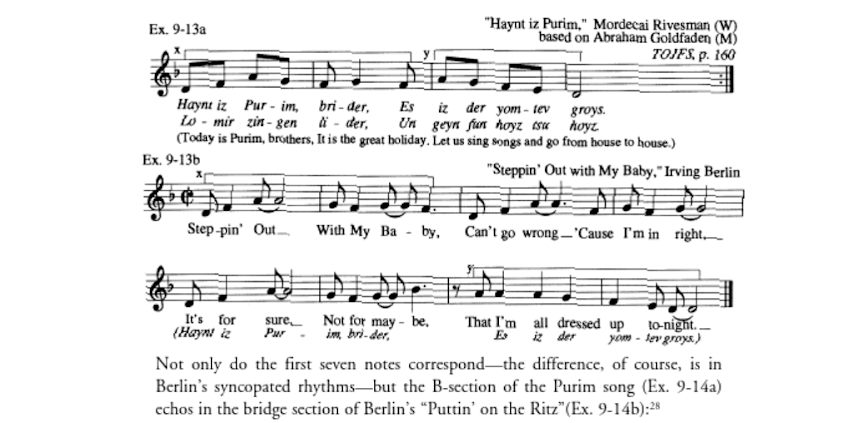
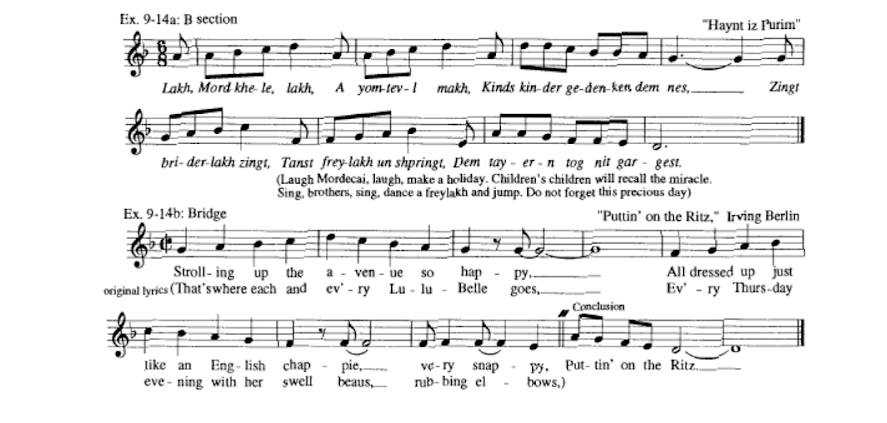
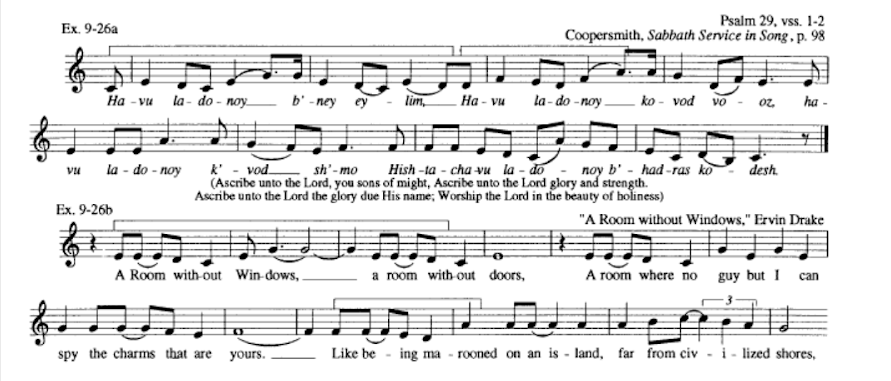
-
Assignment 3 - Jasmine Yuan
Final Project Conceptualization
For this week, I decided to narrow the scope of the project to the music and music spaces of Jewish life in Berlin in the 1920s. The audience for the site will be English-speaking people who are interested in music, music history, and ethnomusicology. They are non-Berlin residents who will learn more about Berlin’s music scene, history, and architecture.
Use Cases
User A is interested in live music from 1920s Jewish culture performed in public settings. They want to learn more about practices in the Yiddish theater, cabaret, and music used in other formal and informal popular performance contexts. User A wants to investigate themes of political and social satire in Weimar era performances.
User B is a music scholar who has an interest in ethnomusicology and music trends specific to Jewish composers in the 1920s. User B is interested in examining the community, market, and connections between Jewish-affiliated musicians, composers, producers, consumers, and record companies in Berlin. They also want to listen to music samples and learn about music writing processes.
User C is a student interested in learning more about liturgical music and music used in sacred and religious contexts. They want to listen to music, explore historic instruments performed in church services, and examine sheet music used in Jewish synagogues.
User D is interested in modern and historic music spaces. They want to see floor plans, pictures of the exterior and interior of places specifically designed for live music performance, and explore architectural design processes for the acoustics of concert halls.
Journey Map
The screen can present a different page for each type of music space or concept. Users navigate to different panels on screens using interactive icons on the page. For example, a page on “Synagogue Music” can have three icons labelled “Music in the Service”, “Sheet Music”, and “Synagogue Acoustics and Architecture”, which users can click on to learn more about and interact with further. Users choose their own path at their own pace using buttons that lead them to different parts around Berlin’s music scene. The audience is presented with “Where do you want to go next?”, along with several choices of locations they have not explored yet.
Notes and Sketches
Sketches: This sketch shows various panels that would be presented to the user as they explore the interface and click around on the “Synagogue Music” page.
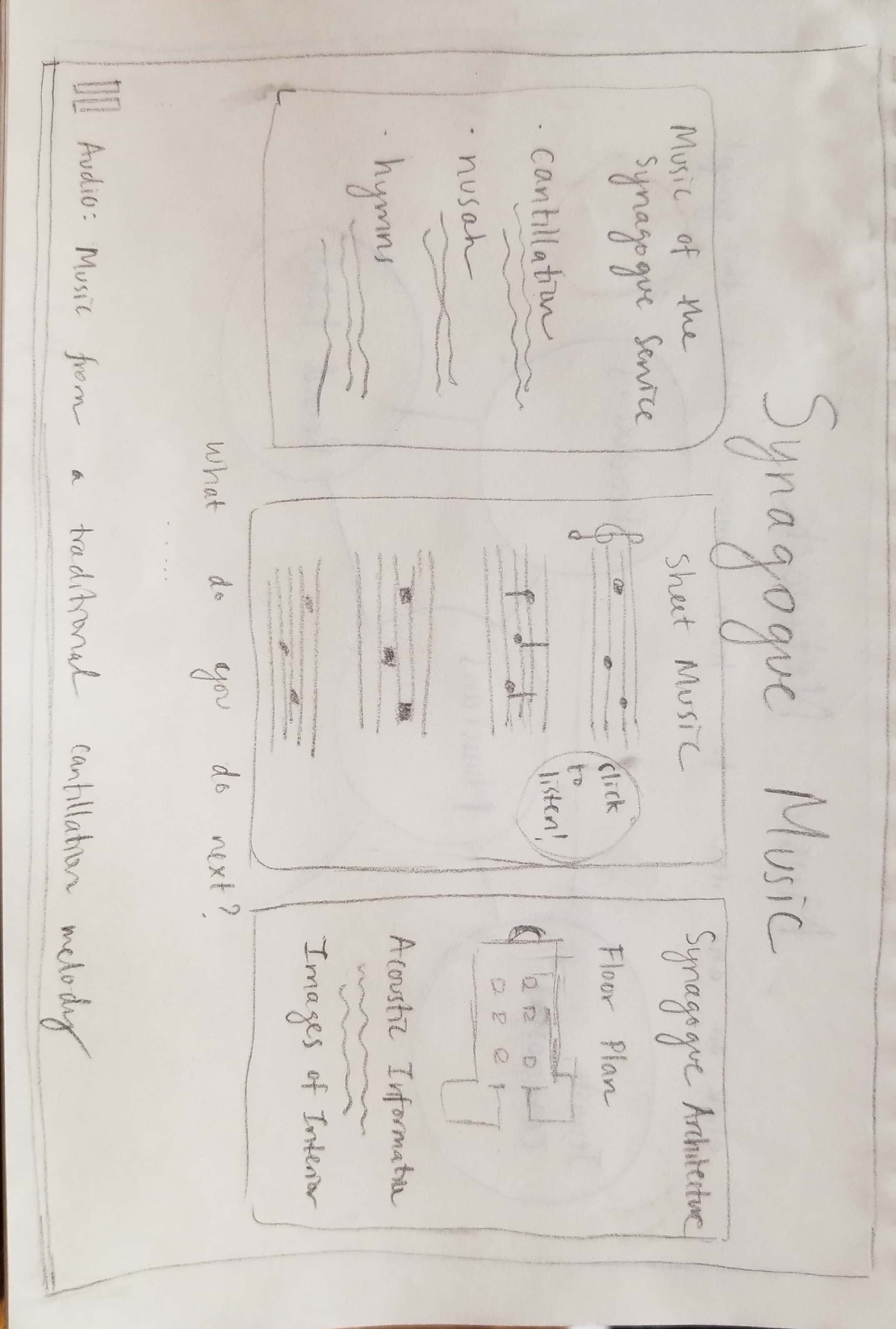
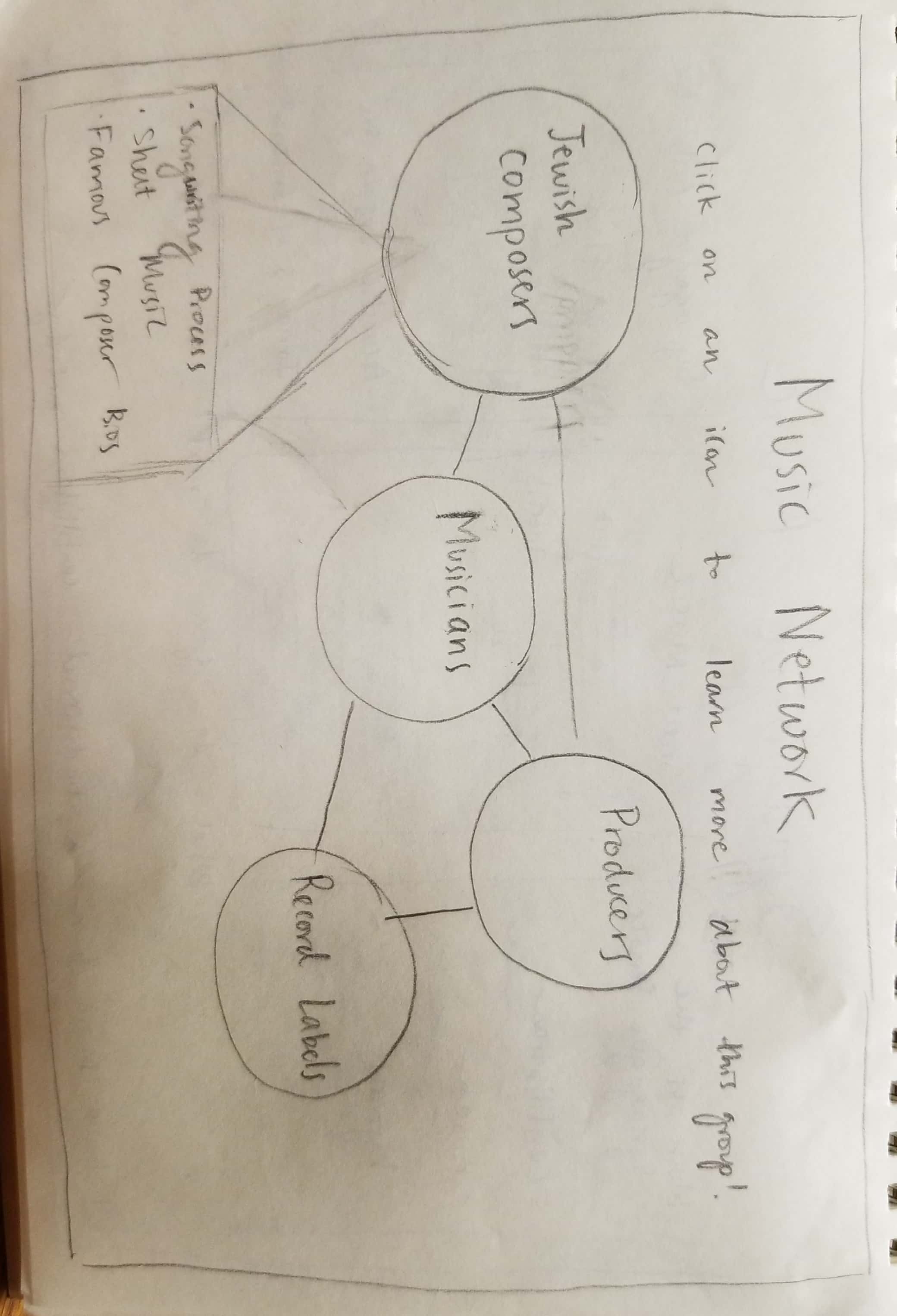
Preliminary notes:
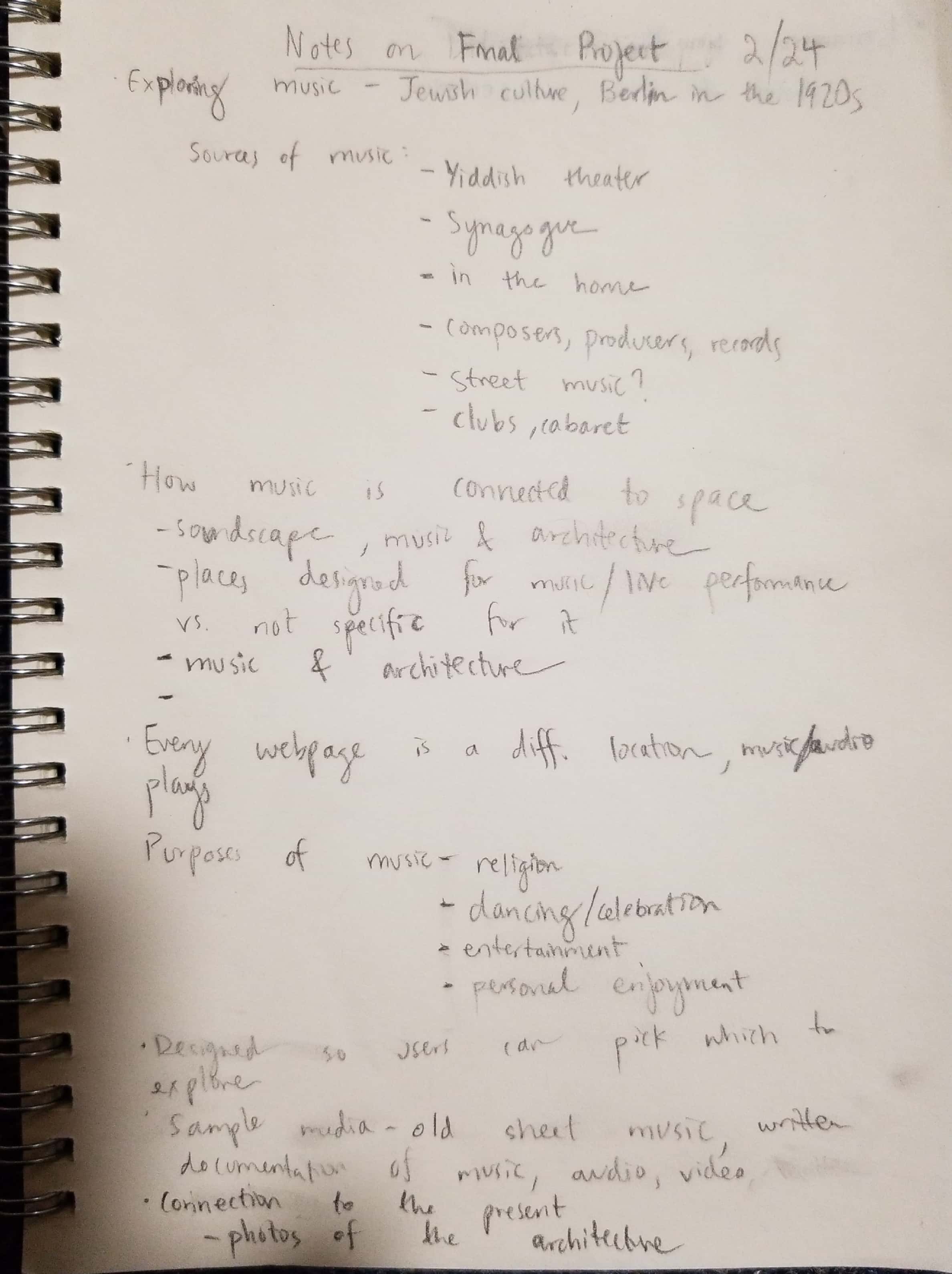
-
Assignment 2 - Jasmine Yuan
Final Project Brainstorming
I am interested in pursuing the topic of Jewish Life in the 1920s in Berlin with Museum 4.0. An idea I would like to explore is creating an interactive storytelling interface on the web. I would like users to gain a glimpse of the daily lives and activities involved in Jewish culture at the time. Once I gather more information about this topic, I can focus on either a more curatorial concept or a personal narrative I want the audience to learn about. I want the story to be interspersed with features such as artwork, audio samples of music and soundscapes, maps, and letters and other forms of correspondence. These artifacts and media will help the project emphasize the vibrant nature of Jewish culture, as well as the impact of the activities and people in that time period on contemporary Berlin.
I found inspiration from this interactive storytelling website, which allows the user to select their path using buttons. Allowing the user to make decisions for the narrative’s arc will make the archive more participatory for the user by giving them more control over the sequence of information presented to them.
Here is a sketch of a sample page in the narrative:
